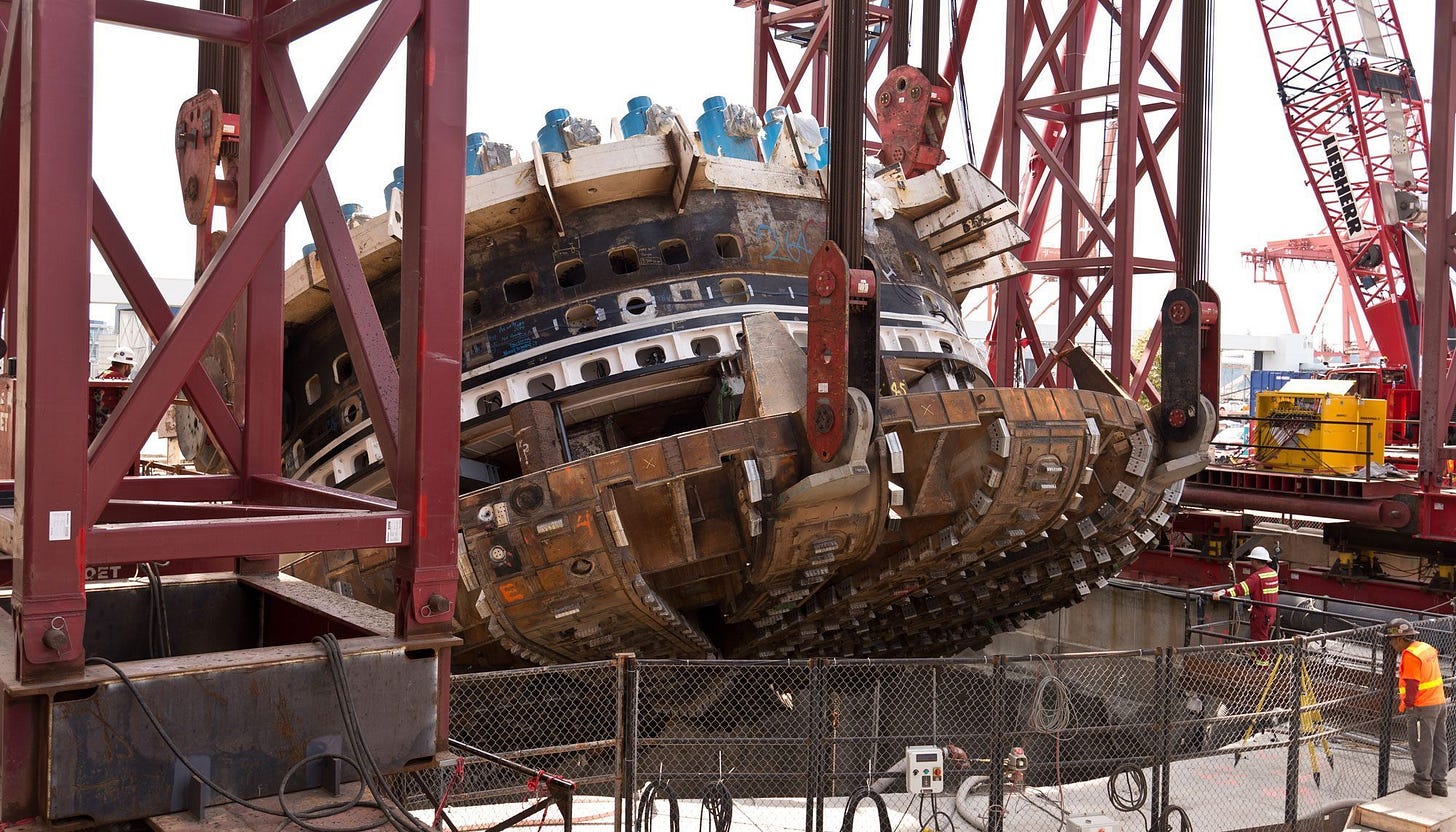Musk’s Boring Company seems poised to be another example of his hubris. It will either pioneer a major breakthrough in underground mining or yet further exemplify the folly of attempting a technological revolution through brute force. It is easy to bring the wrong strategy to an innovation, if you don’t understand its social and economic context. Moving fast may not actually be what you want.
The company’s latest tunnel-boring machine (TBM), called “Prufrock”, is claimed to be 10-15 times more efficient at digging through dirt than existing designs. Traditional TBMs mine earth via a large spinning cutterhead, erecting a set of concrete wall segments every time they progress several feet. These segments don’t just keep the tunnel from caving in. The machines actually inch forward by using powerful hydraulic pistons to push off of these same concrete walls. This arrangement limits its speed. The machine can only continue to mine until it's pistons max out, then it is forced to wait until another row of rectangular segments are erected. It moves like a snake, stretching forward with its head by pushing off with its body.
Prufrock is expected to have a completely automated system for erecting hexagonal concrete segments and a more complex cadence for its pistons, which is supposed to enable continuous mining. Prufock’s digging should look more like the slow glide of a snail rather than the discontinuous start-stop of previous machines. The redesign might drastically alter the economics of tunnel construction.
Might.
Musk’s team has practiced with a standard TBM design, clearly having learned a few lessons from previous instances of overinnovation. And their second-gen TBM, “Line-Storm,” sported a more incremental advancement in the TBM’s cutting head design, which is claimed to make it twice as efficient—actual numbers on its performance are difficult to find. Two recently completed, albeit very short, tunnels constructed by the company, which will let visitors to the Las Vegas Convention center whiz around in Tesla vehicles, at least shows that the Boring Company is accumulating some practical experience, even if the outcome seems suboptimal.
But even given those lessons learned, how much sustainable innovation will come out of this? Part of the claimed efficiency gains comes from the Boring Company focusing narrowly on a single small tunnel diameter, one that fits a Tesla automobile but not much else. The rest is supposed to arrive via revolutionary innovation.
However, traditional TBM’s are more work horses than sports cars for a reason. Any increase in breakdowns and costly repairs quickly eat up the efficiencies gained by a more sophisticated design. The sinking of the Alaskan Way Viaduct, for instance, suffered hundreds of millions in cost overruns when the TBM struck a survey pipe mistakenly left in its path and a 120-foot vertical shaft had to be dug to rescue it.
In industries like mining, where the margins are razor thin and even small mistakes can snowball into financially ruinous quagmires, success is measured less in technical wizardry than in consistency, in avoiding mistakes. Despite Musk’s hype, it may take hundreds of mined miles to work out all the kinks with Prufrock, much less benchmark its actual performance. Test tunnels and short demonstration projects are more like laboratory experiments than practical innovation. If the Boring Company proves successful, we could just as easily credit dumb luck as the firm’s engineering acumen.
This is why Silicon Valley’s old mantra “Move fast and break things,” can often be very bad advice. While it reflects a core piece of wisdom about innovation, that we are reliant on experience. Sometimes “breaking something” means going financially broke and/or sending a potentially promising innovation to the dustbin of history. It gets labeled as “infeasible,” when it was really mismanagement that sunk it. This but one of many reasons why sometimes innovation is too important to leave in the hands of mercurial entrepreneurs.









